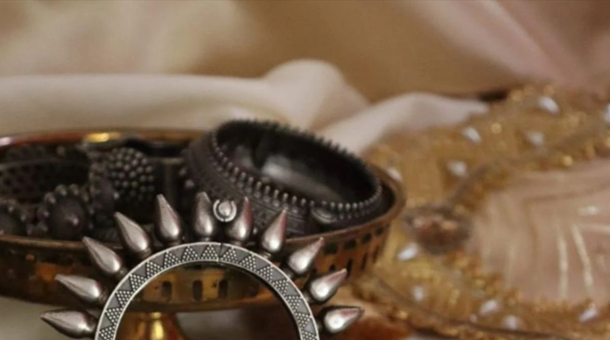The Symbolism Behind Nath, a traditional Indian nose ring worn by women for centuries, is much more than a beautiful piece of jewelry. It is a cultural emblem, a spiritual symbol, and in many communities, a marker of identity and status. Across India, from the intricate Maharashtrian nath to the large Rajasthani borla nathni, this ornament carries layers of meaning that reflect history, mythology, regional customs, and personal expression. Understanding the symbolism behind the nath offers a fascinating insight into how jewelry in India has always been intertwined with life, beliefs, and womanhood.
1. A Symbol of Womanhood and Grace
Traditionally, the nath has been regarded as an adornment that enhances feminine beauty. In many cultures, the nose is associated with intuition, sensitivity, and inner strength—qualities often celebrated in the idea of womanhood. Wearing a nath highlights these features, enhancing the wearer’s elegance and adding a touch of traditional charm.
The Symbolism Behind Nath In Ayurveda, the left nostril is linked to the reproductive organs, and nose piercing is believed to ease menstrual discomfort and childbirth. This belief has enhanced the nath’s symbolism as an ornament closely tied to femininity and fertility. Even today, many families encourage nose piercing for girls not merely as decoration, but as a meaningful cultural step.
2. A Sacred Symbol Rooted in Mythology
The Symbolism Behind Nath holds a special place in Indian mythology. In several stories, goddesses such as Parvati and Lakshmi are depicted wearing nose rings, symbolizing prosperity, power, and divine beauty. These divine associations elevate the nath from a piece of jewelry to a sacred emblem.
In Hindu traditions, marriage rituals often include the bride wearing a nath as part of her solah shringar, the sixteen adornments believed to invoke the blessings of the goddess for a prosperous married life. Wearing the nath during weddings is not just about tradition; it reflects the bride’s transition to a new phase of life, marked by the blessings of the divine feminine.
3. A Cultural Identity Across Regions
India’s incredible diversity is reflected beautifully in the regional variations of the nath. Each style carries its own symbolism and history:
-
Maharashtrian Nath: Distinctive crescent shape with pearls and a red or white stone, symbolizing prosperity and heritage.
-
Rajasthani Nathni: Large, dramatic hoops often connected to the hair with a chain, representing royalty and strength.
-
Punjabi Shikarpuri Nath: Big circular designs decorated with beads and gemstones, symbolizing wealth and family status.
-
Bengali Nose Pin: Simple, elegant studs that reflect minimalism and purity.
-
South Indian Nose Ring: Often elaborate, crafted in gold, and associated with dignity and community pride.
The Symbolism Behind Nath styles show how the nath is not just an accessory but a cultural marker, identifying a woman’s heritage, community, and sometimes marital status.
4. A Marker of Marital Status and Commitment
The Symbolism Behind Nath One of the most prominent symbolic roles of the nath is its connection to marriage. In many Indian communities, a woman wearing a nath signifies that she is married, similar to how a mangalsutra or sindoor functions. The wedding nath is often larger and more ornate, given to the bride by her family or in-laws as a token of blessings.
After marriage, some women wear the nath regularly, while others reserve it for festivals and special occasions. Regardless of usage, the sentiment behind wearing it—representing a woman’s new responsibilities, respect for tradition, and connection with her family—remains strong.
5. A Symbol of Social Status and Wealth
Historically, jewelry in India also served as a display of wealth and status, and the nath was no exception. The material used—gold, pearls, diamonds, rubies—signaled a family’s prosperity. In royal households and affluent communities, naths were often large and heavily embellished to showcase both beauty and economic strength.
Today, this symbolism continues in subtle ways. Brides often choose naths that match their heritage and reflect their family’s cultural and financial standing, blending traditional pride with modern aesthetics.
6. Spiritual and Protective Significance
Beyond beauty and tradition, many believe that the nath carries protective energy. Some communities view it as a talisman that shields the wearer from negative forces or harmful energies. The metallic ring, positioned on the nose—an important point in Ayurvedic and yogic traditions—is said to balance emotional energies, calm the mind, and promote inner harmony.
For this reason, the nath is often included in spiritual rituals, classical dance performances, and religious ceremonies, symbolizing purity, protection, and devotion.
7. A Bridge Between Tradition and Modernity
In recent years, the nath has experienced a revival. With Bollywood actresses, influencers, and brides sporting traditional or fusion nath designs, the ornament has gained popularity beyond cultural boundaries. Modern naths range from minimalist gold hoops to bold, designer pieces that blend old-world charm with contemporary aesthetics.
Today, women wear the nath not just for weddings or rituals but as a personal style statement. It has become a symbol of individuality and empowerment—a way to celebrate heritage while embracing modern fashion choices.
8. A Symbol of Emotional Connection and Family Legacy
Many families pass down naths from one generation to the next. These heirloom pieces carry emotional value, memories of mothers, grandmothers, and ancestral traditions. Wearing such a nath becomes a warm, sentimental experience, connecting the wearer with her roots, identity, and family history.
This emotional symbolism gives the nath a timeless quality. It’s not merely jewelry—it’s a story, a legacy, a bond between generations.
Conclusion
The symbolism behind the nath is as rich and diverse as Indian culture itself. It represents femininity, spirituality, marital blessings, regional identity, social status, and emotional connection. Whether worn during a grand wedding or as a modern fashion choice, the nath carries with it centuries of tradition and meaning.
What makes the nath truly special is its ability to adapt with time—honoring ancient beliefs while embracing modern expressions of beauty and individuality. Through its many layers of symbolism, it continues to be one of the most treasured and meaningful ornaments in Indian culture.

